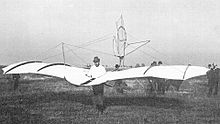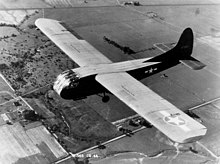Glider



A glider (or glider for short ) is an aircraft without a motor that generates forward movement in the air solely by converting altitude ( positional energy ) into lift and propulsion ( gliding ). The first man-carrying “ heavier than air ” aircraft with which repeatedly controlled flights were carried out - the “ Derwitzer Gleiter ” built and flown by Otto Lilienthal in 1891 - was a foot-launchable glider.
The boundaries between gliders and gliders, which are usually also motorless, are fluid. In the narrow sense refers only motorless aircraft as gliders, because of their construction ( glide ) are unable to normally in the atmosphere occurring thermals to gain altitude. In particular, gliders for training beginners in gliding , which only have a low glide ratio, were previously referred to as gliders or school gliders .
The term “glider” has been used in aviation regulations for special air sports equipment since the 1990s .
history
George Cayley
George Cayley began to build large monoplane gliders in 1804 , which already showed great similarities to today's gliders with large front wings, smaller tail wings and horizontal stabilizers. In 1809, according to Cayley's own report in the Journal of Natural Philosophy, Chemistry and the Arts , Volume 24, there was an unmanned glider flight. In September 1852 Cayley published the article Sir George Cayley's Governable Parachutes ( Eng . Sir George Cayley's controllable parachutes) in Mechanics' Magazine , which contains the plans and descriptions for a single-wing glider. Cayley points out in his article that this aerial vehicle (dt. Aircraft) has been tested extensively without a pilot with ballast weighing one pound on the square feet of space .
Lilienthal glider
The first reproducibly controlled flights with man-carrying “heavier-than-air” aircraft were gliding flights and were carried out in Derwitz by Otto Lilienthal in 1891 with the Derwitz apparatus , a foot-launchable glider - controlled by the pilot through weight control . Foot launch capability means that the pilot runs down a slope with the device on his shoulders and accelerates until the wing carries him and lifts him off the ground. In order to be able to perform gliding flights systematically and regularly, Lilienthal had the Fliegeberg built in 1894 . For many practical flying experience were even after Lilienthal's death in 1896 by Octave Chanute , Augustus Herring , Ferdinand Ferber and others to realization of powered flight fußstartfähige gliders built and used.
Wright Brothers
The Wright brothers used glider planes to develop their wing profile and turn control - synchronization of wing twisting / aileron deflection with the deflections of a movable rudder - before they turned to powered flight .
Basic principle


In principle, any aircraft can be used as a glider and in practice the gliding capability is also used in emergencies. For example, put a Airbus A330 at Air Transat Flight 236 a distance of 120 km back glide. The ditching of US Airways flight 1549 on the Hudson River was carried out in gliding flight after a complete engine failure.
Special glider planes
A number of aircraft types, which are intended for special flight missions, are designed for unpowered landings as pure gliders. Belong to this group
- School gliders , on which flight students learned to fly in the early days of gliding;
- Raab-Katzenstein RK 7 , a towing glider that was specially developed in 1927 for testing and demonstrating aircraft towing ;
- Cargo gliders and special gliders that are towed close to the target with tow planes in order to then operate independently in gliding flight (e.g. Waco CG-4A , DFS 230 , Blohm & Voss BV 40 );
- many types of rocket aircraft , e.g. B. the interceptor Me 163 (1941) and the supersonic experimental aircraft Bell X-1 (1946), which land as gliders;
- the Space Shuttle space shuttles (1977), which land as pure glider planes after re-entering the atmosphere;
- SpaceShipOne (2003), the experimental aircraft for suborbital flight that lands in controlled gliding flight.
Aerial sports equipment
Admission
Today's glider planes are foot-launchable gliders that are approved in Germany according to § 1 Para. 4 LuftVZO as “ air sports equipment ” or in Austria as “restricted special class”. They are characterized by their low weight, low possible flight speeds and the emphasis on personal responsibility in the relevant legal regulations. In contrast to the hang glider with a flexible wing , a glider has a rigid wing.
Air sports equipment class ultra-light gliders
Gliders belong in Germany to supplement the 1993 adopted "Luftsportgeräte Regulation" in the Luftsportgeräte class of "ultralight gliders." Ultralight gliders do not have to be foot-launched, so this class also includes types that are heavier and also have a higher minimum speed than gliders. The licensing limits of ultra-light gliders for both values are 55 km / h and 120 kg empty weight, whereas the required foot launch capability for gliders requires a minimum speed of 30 km / h and a maximum empty weight of around 50-60 kg.
Within the aerial sports equipment, the gliders are not assigned to the microlight planes, but form a separate subgroup that was added later , alongside microlight planes , hang-gliders , paragliders and parachutes . A separate pilot's license is required to operate a glider.
Advocacy
In Germany there are the German Aero Club e. V., German Hang Glider Association and DULSV (UL gliders). The associations agreed that the DAC and DULSV should contribute to the regulations necessary for operation and technology for devices controlled around three axes. The DHV is dedicated to the hang-glider-like, weight-controlled gliders.
Examples of foot-launchable gliders
- ULF-1 , 1977
- Aériane Swift , 1989
- Ruppert Archeopteryx , 2001
See also
Web links
- German Ultralight Glider Association (DULSV)
- German air traffic control: News for pilots: Announcement of airworthiness requirements for glider planes 1 (PDF)
Individual evidence
- ↑ Authority record GND 4157579-9 , accessed on December 26, 2019.
- ↑ George Cayley: Sir George Cayley's Governable Parachutes . In: Mechanics' Magazine . No. 1520 , September 25, 1852, p. 241 ff . ( aviation-history.com [accessed August 25, 2015]).


